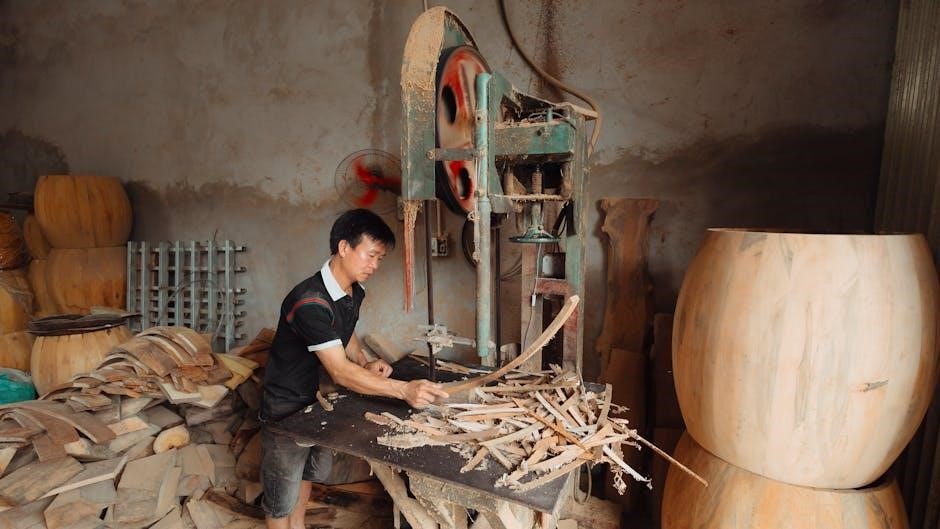
hole saw guide
Hole saws are versatile tools used for cutting precise circular openings in various materials, offering efficiency and accuracy for drilling projects. This guide explores their functionality, types, and best practices.
1.1 What is a Hole Saw?
A hole saw is a specialized cutting tool used to create precise circular openings in various materials such as wood, metal, and plastic. Unlike traditional drill bits, hole saws are designed for making large-diameter holes efficiently. They typically consist of a cylindrical blade with sharp teeth and a pilot bit that guides the saw. Available in different types, including bi-metal and carbide-tipped, hole saws are versatile tools essential for various drilling tasks, ensuring clean and accurate cuts.
1.2 Choosing the Right Hole Saw for the Job
Selecting the appropriate hole saw depends on the material, thickness, and desired hole size. Bi-metal hole saws are ideal for wood and thin metal, while carbide-tipped saws are better for tough materials like stainless steel. Diamond-coated saws excel with tile, glass, or stone. Consider the tooth count for finish quality and the arbor size for compatibility with your drill. Always match the saw to the job requirements for optimal performance and longevity of the tool.

How Hole Saws Work
Hole saws function by rotating a cylindrical blade with sharp teeth around a central arbor, cutting material as the saw spins, creating precise circular openings efficiently.
2.1 Key Components of a Hole Saw
A hole saw consists of a cylindrical blade with sharp teeth, a central arbor for stability, and a pilot bit for guidance. The blade cuts material, while the arbor holds it rigidly. The pilot bit ensures accurate centering, preventing drift. Common materials include bi-metal for durability and carbide tips for tough materials. These components work together to deliver precise, clean cuts in various materials like wood, metal, and plastic, making hole saws indispensable for drilling projects.
2.2 Understanding the Cutting Process
The cutting process begins with the pilot bit creating a starter hole, guiding the hole saw. As the saw rotates, its teeth remove material, creating a circular opening. The process requires steady rotational force and proper alignment to ensure clean cuts. The saw’s design allows for efficient material removal, with the teeth cutting along the edge while the center remains intact. Maintaining consistent speed and pressure is crucial for precise results, avoiding overheating and ensuring smooth operation across various materials.

Types of Hole Saws
Hole saws come in various types, each designed for specific materials. Bi-metal saws are versatile for wood and metal, carbide-tipped for tougher materials, and diamond-coated for the hardest surfaces.
3.1 Bi-Metal Hole Saws
Built for versatility, bi-metal hole saws combine a durable steel body with high-speed steel teeth, making them ideal for cutting through wood, plastic, and thin metal. Their robust construction ensures long-lasting performance and precision in various materials, while maintaining affordability. These saws are a go-to choice for professionals and DIYers due to their wide range of applications and reliable results across different projects.
3.2 Carbide-Tipped Hole Saws

Carbide-tipped hole saws are designed for cutting harder materials like metal, stainless steel, and thick plastics. The carbide edge offers superior durability and resistance to wear, making these saws ideal for demanding tasks. They maintain sharpness longer than bi-metal saws, reducing the need for frequent replacements. While more expensive, their performance in tough materials makes them a valuable investment for professionals requiring precise and efficient cuts in challenging projects.
3.3 Diamond-Coated Hole Saws
Diamond-coated hole saws are specialized tools for cutting through extremely hard materials such as glass, ceramics, and concrete. The diamond coating provides exceptional hardness and heat resistance, ensuring long-lasting performance. These saws are ideal for tasks requiring precise cuts in tough, abrasive materials. While they are more expensive than other types, their durability and cutting efficiency make them indispensable for professionals tackling demanding projects that require superior cutting power and longevity.

Materials Hole Saws Can Cut Through
Hole saws are versatile tools for cutting various materials, including wood, metal, plastic, drywall, and plaster, making them essential for diverse projects.
4.1 Wood
Hole saws excel at cutting through wood, making them ideal for woodworking projects. They can handle various wood types, from softwoods to hardwoods, ensuring clean, precise circles. Bi-metal hole saws are often recommended for woodworking due to their durability and sharpness. Using a pilot drill bit helps guide the saw and prevents wandering. Maintaining consistent drilling speed and applying steady pressure ensures smooth cuts and prevents splintering. Regular maintenance, like cleaning teeth, prolongs the saw’s efficiency in woodworking tasks.

4.2 Metal
Metal cutting with hole saws requires precision and the right tools. Carbide-tipped hole saws are ideal for cutting through metal, as they offer superior hardness and durability. They can efficiently cut through materials like steel, aluminum, and stainless steel; Using a pilot drill bit ensures accurate alignment and prevents the saw from slipping. Applying coolant or cutting oil can reduce friction and prevent overheating, ensuring cleaner cuts and extending the life of the hole saw. Regular maintenance is key for optimal performance in metal cutting tasks.
4.3 Plastic
Hole saws can effectively cut through plastic materials, including PVC, acrylic, and polycarbonate. Using a bi-metal or carbide-tipped hole saw is recommended for plastic, as they provide clean cuts and minimize melting. Applying light to moderate pressure while maintaining consistent speed helps prevent overheating. Using a pilot drill bit ensures accurate centering. For thicker plastics, cooling with water or cutting oil can reduce heat buildup. Regular cleaning of the saw teeth ensures optimal performance and prevents residue from interfering with future cuts.
4.4 Drywall and Plaster
Hole saws are ideal for cutting smooth, precise openings in drywall and plaster. Use a bi-metal or carbide-tipped hole saw for these materials. Apply steady, light pressure and use a pilot drill bit for accuracy. Vacuuming dust during cutting prevents buildup and improves visibility. Avoid excessive pressure to prevent cracking, especially in plaster. For thicker drywall, consider using a hole saw with deeper cutting capacity. Regular cleaning of the saw teeth ensures optimal performance and prevents dust residue from affecting future cuts.

Safety Tips for Using a Hole Saw
Always wear safety goggles and gloves. Secure the workpiece firmly to prevent movement. Maintain a firm grip on the drill and avoid loose clothing near the tool.
5.1 Proper Safety Gear
Wearing proper safety gear is essential when using a hole saw. Always wear safety goggles to protect your eyes from debris. Gloves provide grip and protect hands from sharp edges. A dust mask is recommended when cutting materials like drywall or plastic to avoid inhaling particles. Ensure loose clothing or long hair is tied back to prevent accidental entanglement with the drill. Steel-toe boots and an apron can offer additional protection in a workshop setting.
5.2 Securing the Workpiece
Securing the workpiece is crucial for safe and accurate cutting. Use clamps or a vise to firmly hold the material in place, preventing movement during the cutting process. A loose workpiece can lead to accidents or uneven cuts. Ensure the material is stable and tightly secured before starting the drill. This step minimizes the risk of the hole saw binding or the material slipping, ensuring a smooth and controlled operation. Properly securing the workpiece is essential for both safety and achieving professional results.
5.3 Avoiding Overheating
Avoiding overheating is essential to maintain the longevity of your hole saw and ensure safe operation. Overheating can occur due to excessive friction, improper speed settings, or continuous use without cooling. To prevent this, apply steady, moderate pressure and use cutting fluids or water for materials like metal. Allow the tool to cool periodically during prolonged use. Overheating can dull the teeth, warp the saw, or damage the motor. Monitoring temperature and maintaining proper technique will help avoid these issues and ensure precise cuts.

Best Practices for Cutting
Best practices include proper alignment, steady pressure, and consistent speed to ensure clean cuts. Regular tool maintenance and material-specific techniques maximize efficiency and safety in all applications.
6.1 Starting the Cut
Starting the cut requires proper alignment and a steady hand. Center-punch the material to guide the saw. Align the drill bit with the center mark and begin at a slow RPM. Apply consistent, light pressure to avoid slipping. Gradually increase speed as the cut progresses. Maintain control to prevent the saw from binding. Ensure the workpiece is secure to avoid movement during the process. Proper starting techniques ensure accuracy and safety, setting the stage for a clean, precise cut.
6.2 Maintaining Speed and Pressure
Maintaining optimal speed and pressure is crucial for a clean, efficient cut. Avoid applying excessive pressure, as this can cause overheating or binding. Use a steady, consistent motion, adjusting RPM based on material thickness and type. Softer materials may require lower speeds to prevent tearing, while harder materials can handle higher RPM. Keep the drill bit cool by reducing pressure if it begins to overheat. Consistent pressure ensures a straight cut without applying too much force, which could lead to the saw binding. Monitor progress and adjust as needed for the best results;
6.3 Finishing the Cut
As you near the end of the cut, reduce drill speed to prevent the material from tearing. Avoid applying extra pressure, as this can cause the hole saw to bind or the material to break unevenly. Once the cut is complete, allow the tool to come to a full stop before withdrawing it. Inspect the hole for rough edges and use a file or sandpaper to smooth them out if necessary. Properly finishing ensures a clean, professional result and prolongs the life of the hole saw.

Maintenance and Care
Regular maintenance ensures longevity and optimal performance of hole saws. Clean debris after use, store in a dry place, and sharpen teeth as needed.
7.1 Cleaning the Hole Saw
Cleaning your hole saw is crucial for maintaining its performance. Use a stiff brush to remove debris from the teeth and core. For tough residue, apply a mild solvent and scrub gently. Avoid harsh chemicals that could damage the coating. Dry thoroughly after cleaning to prevent rust. Regular cleaning ensures optimal cutting efficiency and extends the tool’s lifespan. Proper maintenance helps retain sharpness and prevents material buildup, keeping your hole saw in top condition for future projects.
7.2 Storing the Hole Saw
Proper storage is essential to maintain your hole saw’s condition. Keep it in a dry, secure location to prevent rust and damage. Store the tool in its protective case or separately from other equipment to avoid scratching. Avoid exposing it to moisture or extreme temperatures. Hang it securely or place it on a stable surface away from children. Regularly inspect for damage before use. Proper storage ensures longevity and maintains the saw’s cutting efficiency for future projects.
7.3 Sharpening the Teeth
Sharpening the teeth of your hole saw is crucial for maintaining its performance and extending its lifespan. Start by cleaning the saw to remove any debris. Use a diamond file or sharpening stone specifically designed for metal tools. Lightly sharpen each tooth in a uniform manner, ensuring consistent sharpness. Be careful not to apply too much pressure, as this can damage the teeth. Regular sharpening prevents dulling and ensures precise cuts. Always refer to the manufacturer’s guidelines for specific sharpening recommendations.

Troubleshooting Common Issues
This section addresses common problems like binding, uneven cuts, and worn teeth, offering practical solutions to restore your hole saw’s performance and ensure smooth operation.
8.1 The Hole Saw is Binding
Binding occurs when the hole saw seizes during cutting, often due to improper material engagement or insufficient lubrication. To resolve this, stop the tool immediately and assess the situation. Ensure the workpiece is securely held to prevent movement. Applying cutting oil or coolant can reduce friction and help the saw operate smoothly. If the issue persists, check for dull teeth, as they can cause excessive heat buildup and lead to binding. Always maintain consistent pressure and avoid applying too much force, which can exacerbate the problem. Regular maintenance, such as sharpening the teeth, can also prevent binding by ensuring efficient cutting. Additionally, using the correct type of hole saw for the material being cut is crucial to avoid such issues. By addressing these factors, you can minimize the risk of binding and ensure safer, more effective cutting operations. Proper technique and tool maintenance are key to preventing this common problem and prolonging the life of your hole saw.
8.2 The Cut is Uneven
An uneven cut can result from improper alignment, uneven material, or inconsistent drilling pressure. To address this, ensure the hole saw is centered and the workpiece is securely clamped. Using a pilot drill bit helps maintain accuracy. Apply steady, consistent pressure while drilling, and avoid applying too much force, which can cause the saw to wobble. For materials like wood or plastic, using a bi-metal or carbide-tipped hole saw can improve cut quality. Regularly inspect and maintain the tool to ensure sharpness and alignment. Proper technique and tool selection are key to achieving smooth, even cuts. If the issue persists, consider using a stabilizing guide or jigsaw for better control.
8.3 The Teeth are Wearing Down Quickly
The teeth of a hole saw can wear down rapidly due to improper material matching or excessive use on hard substances. To prevent this, ensure the saw is suited for the material being cut. Dull teeth can be sharpened, but frequent wear may require replacement. Using the correct drilling speed and avoiding excessive pressure can extend the tool’s life. Regular maintenance, such as cleaning and storing properly, also helps preserve the teeth. Always inspect the saw before use to ensure optimal performance.
Related Posts

everquest lvl guide
Stuck in a leveling rut in EverQuest? Our guide cuts through the grind with proven strategies, class tips, and the fastest routes to 85! Level up now!

acs organic chemistry study guide pdf free download
Download our comprehensive organic chemistry study guide PDF. Perfect for students and self-learners! Boost your chemistry knowledge today!

guide pro pants
Discover the ultimate Guide Pro Pants, crafted for professionals seeking durability and comfort. Perfect for any task, these pants are your reliable work partner.